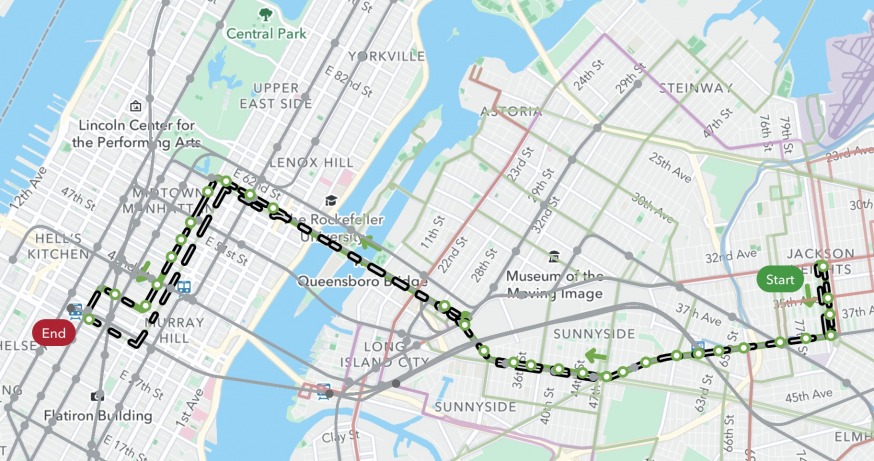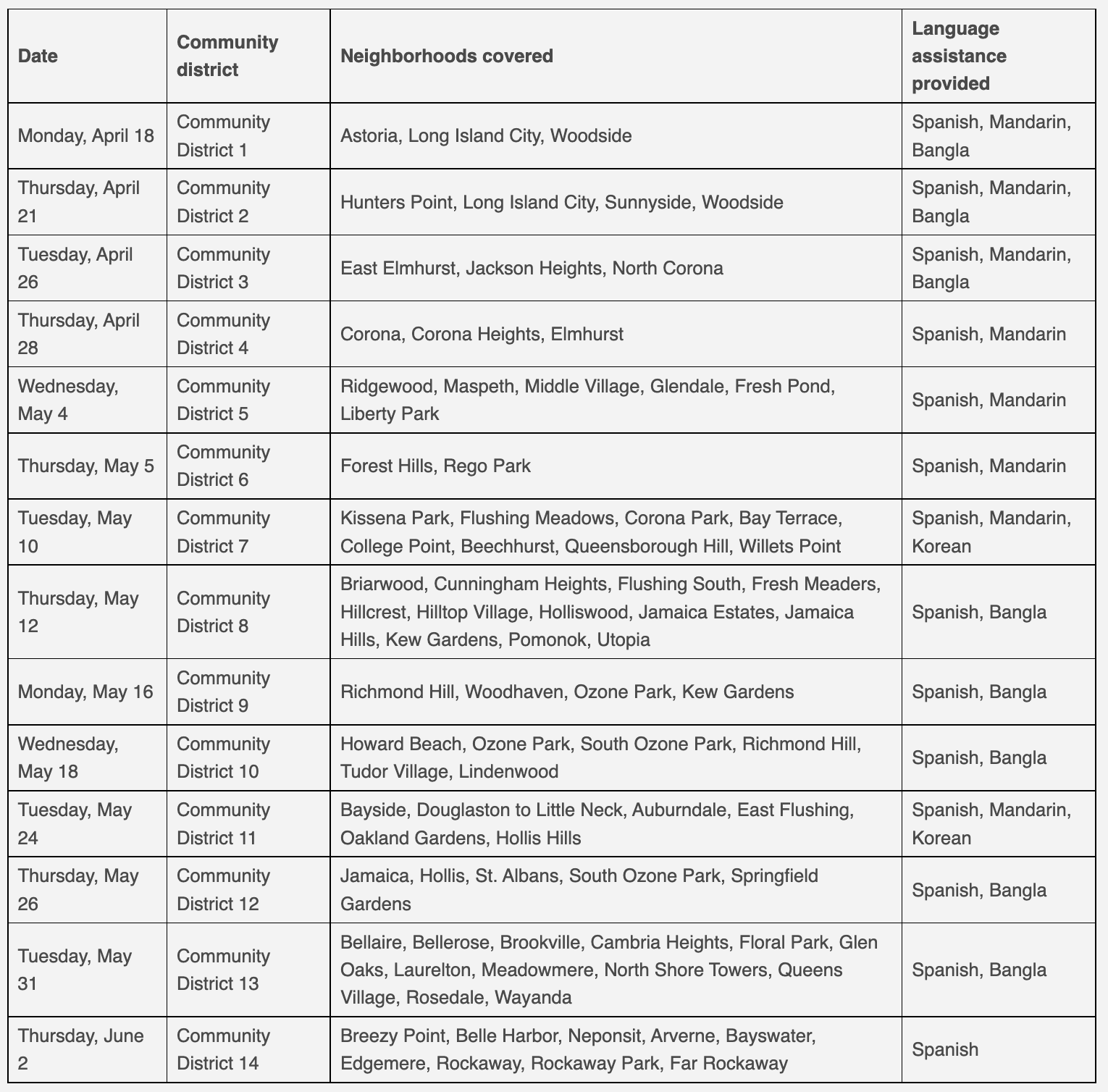
MTA Chair & CEO Janno Lieber, Interim NYCT President Craig Cipriano, Acting MTA Bus President/SVP NYCT Buses Frank Annicaro, DOT Commissioner Ydanis Rodriguez and Queens Borough President Donovan Richards announce the Queens Bus Network Redesign Draft Plan at Jamaica Avenue & 150th Street on Tuesday (Marc A. Hermann / MTA)
March 29, 2022 By Allie Griffin
The Metropolitan Transportation Authority unveiled a revised draft bus plan Tuesday that would overhaul the existing bus network in Queens.
The 515-page updated plan replaces an original 2019 draft plan that the MTA decided to scrap because it was highly unpopular among borough residents and officials.
MTA officials, Queens Borough President Donovan Richards Jr. and DOT Commissioner Ydanis Rodriguez announced the new plan at a press conference in Jamaica Tuesday.
The revised plan, just like the previous draft, aims to redo the bus network across the borough to increase reliability and bus speeds. The system, which caters to about 800,000 average weekday riders, has largely been unchanged since the turn of the 20th century and many argue its service area also needs to be expanded.
“Queens has, historically, had less subway service relative to its size and population than the other boroughs,” said MTA Chair and CEO Janno Lieber, who noted that this needs to change. “The New Draft Plan reimagines both local and express service to address the evolving needs of Queens communities, with a focus on more reliable service, faster travel, better connections, and ease of use.”
The original draft plan released in 2019 faced heavy criticism and the MTA has gone back and drawn up a new plan. The initial draft was panned by residents and elected officials for eliminating and splitting up a number of bus lines that many deemed crucial components of the network.
The MTA received more than 11,000 comments on the original draft plan in three months — an unprecedented amount for any recent MTA project. Residents from Sunnyside, Jackson Heights, Forest Hills and throughout the borough slammed the plan. Many put together online petitions in opposition to it and blasted MTA officials at local community board meetings.
In addition, all 15 Queens council members at the time called on the MTA to completely re-do the original draft plan. They rallied on the steps of Queens Borough Hall and sent a letter to MTA officials to demand a new plan shortly after the original draft was released.
The MTA, after putting its initial plan on pause when COVID-19 broke out, decided later to trash the 2019 draft plan and craft a new one based on the feedback it received from residents and officials.
“Queens families rely heavily on bus service…so it could not be more important that we get this redesign of our borough’s bus network right,” Richards said Tuesday. “I look forward to working with the MTA to ensure our families are not only actively involved, but centered in this redesign.”
The revised draft plan is a less severe than the pre-pandemic plan, the agency said.
“Yes, this is still an ambitious plan aimed at improving bus travel for Queens riders, but this reimagined version of the network will look a bit more familiar to you,” the MTA said.
The revised plan includes 85 local bus routes, up from the existing 82 bus routes in the current network and the 77 that were proposed in the old draft plan. The new plan also includes 28 express bus routes.
The 85 proposed bus routes look more similar to the current routes, but nearly all have been changed in some way. The MTA has proposed extending some routes while shortening others, combining multiple routes and realigning routes to serve other streets. It has also drafted completely new routes while keeping some routes the same with different and/or fewer stops.
Queens residents had decried changes to bus routes like the Q23, Q32, Q33, Q49, Q53, Q60 and Q66 lines in the old plan. Many of the routes in the 2019 plan were shortened or scrapped and replaced with two or three routes to make up the full route distance.
In response, the MTA crafted new route alternatives that addressed their criticisms in its revised plan.
“We looked at every major routing concern and proposed new route alternatives that address each concern,” the agency said in the new plan.
Under the new plan, the routes for the Q23, Q32, Q33, Q49, Q53, Q60 and Q66 buses were only slightly changed — if at all.
Two Queens-Manhattan lines, the Q32 Jackson Heights-Penn Station route and the Q60 Queens Boulevard route, will continue to run from borough to borough under the new draft plan after residents complained that the lines would end in Queens under the pre-pandemic plan. Both routes, however, will have fewer stops for faster service.

Q32 service will continue into Manhattan. The green line shows the proposed Q32 route under the new draft plan, while the black dotted line shows the current Q32 route (MTA/Remix)

The proposed Q60 route, shown in green, is nearly identical to the current Q60 route, shown in black. (MTA/Remix)
Residents can compare the proposed bus routes in the new draft plan to the existing bus routes side-by-side on an interactive map.
The MTA also opted to keep the names of bus routes the same as existing ones with the letter Q and a number to avoid the confusion caused by using “QT” plus a number as in the 2019 plan.
Another concern Queens residents had from the old draft plan was the distance between bus stops. The current average distance between bus stops in Queens is about 910 feet. The old plan proposed increasing the distance to about 1,400 feet apart on average. The new plan proposes increases of between 1,060 and 1,320 feet for local routes.
The MTA plans to cut the number of stops on 79 out of the 85 lines, with a net loss of 1,685 stops in the borough. Fewer stops will speed up bus service, according to the agency. In Queens, the average speed of buses last month was 9.1 miles an hour.
However, some transportation advocates say that fewer bus stops will reduce transit accessibility for seniors and people with disabilities.
“Our senior citizens and the ADA community must have bus stops that are easily available to them,” public transit advocacy group Passengers United said in a statement. “This new plan calls for the elimination of many bus stops in Queens…This is degrading to us.”
Other transportation groups, like Riders Alliance and Transportation Alternatives, meanwhile, were optimistic about the new bus draft plan.
“We’re excited to see how [the] @MTA has integrated the massive amounts of rider feedback they got before pausing their initial redesign effort back in early 2020,” Riders Alliance wrote on Twitter.
Several Queens lawmakers also said they were happy that the MTA considered residents’ concerns from the first plan and created a whole new one.
“Two years ago, our community came out in force to voice their concerns about the MTA’s original bus redesign, finding that it fell far short of our expectations,” State Senator John Liu, member of the Senate Committee on Transportation, said in a statement. “With this new draft plan, we are eager to see that the results of our feedback include several driving principles to expand and improve the bus network, get more commuters on the bus, and include more express service.”
Liu’s colleague in the Assembly, Assembly Member Edward Braunstein, likewise, said the new plan is a large improvement from the prior plan.
“I appreciate that the MTA acknowledged that the first draft of the Queens Bus Network Redesign was flawed and opted to develop an entirely new draft plan, taking into consideration over 11,000 comments they received from Queens residents,” Assembly Member Edward C. Braunstein said in a statement. “The New Draft Plan, while still imperfect, makes a number of common sense improvements from the last proposal.”
The revised draft plan is about to undergo public scrutiny. The MTA will collect feedback from residents and local officials to help craft the final version.
In order to gather that feedback, the agency is hosting a series of 14 virtual workshops — one for each community district — on the new draft plan from April through June. MTA representatives will present information on the changes proposed within the new draft plan and invite attendees to share their questions, comments and concerns at the workshops.
All 14 workshops will begin at 6:30 p.m. and end at 8:30 p.m. on their scheduled date. The first workshop will be held on Monday, April 18 for Queens Community Board 1 residents.
Residents interested in attending a workshop should register here. If a resident cannot attend the workshop scheduled for their community, they can attend a different one, the MTA said. The full schedule is below and can also be found on the MTA’s Queens Bus Network Redesign website.

(MTA)
Queens officials, many of whom represent areas considered transit deserts, urged residents to attend the workshops and share their thoughts on the revised bus plan.
Council Member Robert Holden, who represents Middle Village, Maspeth and Glendale, said better bus options are critical for his constituents given the lack of subway service.
“My district is a transportation desert and increasing my constituents’ options to get around the city and borough is critical,” Holden said in a statement. “I look forward to working with the MTA on ensuring that their New Draft Plan for the Queens Bus Network Redesign addresses the needs of my constituents.”
Council Member Julie Won said buses are often the core transit options for mothers, immigrants and working-class families. She said the opportunity to provide feedback is a “once-in-a-generation chance” to shape the way Queens residents get around the city for the better.
“The MTA wants a Queens bus redesign that recognizes the needs of our communities and improves our bus service,” Won said in a statement. “It is crucial that we show up and let the MTA know where we need to go – to our doctor’s office, to our daycare, to our business, to our parents.”
Residents can submit a comment on the new bus redesign draft plan online here.
